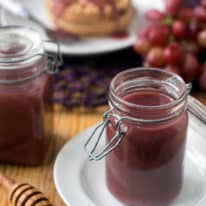Seasonality:
- Depending on the variety, grapes are in season April through December.
Health Benefits of Grapes:
- Grape of excellent source of Vitamin C, potassium and Vitamin K.
- The polyphenols found in grapes have been shown to reduce the risk of heart disease.
- Here’s 10 reasons to eat more grapes!
How to Select Grapes:
- Check the color: Green grapes are best when they’re a yellow-green color, red grapes are best when predominantly red, and black grapes are best when they have a rich, full color.
- Grapes should be firm, plump and firmly attached to the stems. Avoid grapes that are wet, moldy or shriveled at the stem.
- If you see a powdery-white coating on your grapes, don’t worry! It’s bloom, a naturally-occurring substance that helps protect the grapes from moisture loss.
How to Store Grapes:
- Before storing, check grapes for any signs of mold, shriveling or poor stem attachment. Any grapes with these signs will deteriorate quicker and affect those grapes around them.
- Store grapes unwashed in original package. Grapes are best kept near the back of the refrigerator where it’s coldest.
- Make sure to keep them away from strong foods, such as garlic or onions, as grapes can absorb odors from food around them.
How to Prepare Grapes:
- Rinse before eating.
- To freeze grapes, rinse and pat dry. Lay single layer on baking sheet and freeze up to 2 hours. Transfer to freezer-safe Ziplock bag. Watch this video to see how easy it is!
Fun Facts About Grapes:
- There are over 8,000 grape varieties worldwide.
- The USA imports 25% of their grapes from Chile.
- Grapes are botanically classed as berries.
Learn more at CA Table Grape Commission
Get additional resources in our Nutrition Education Center

































